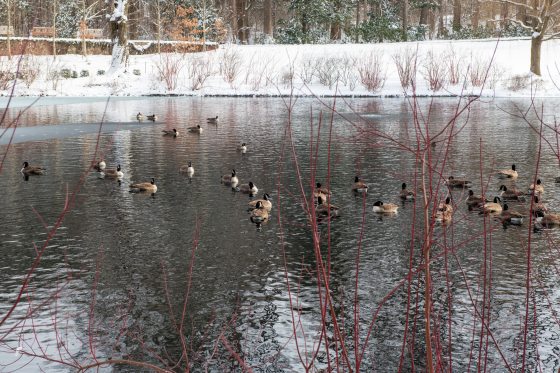From the finest details to large ambitious projects that span acres, conservation is at the core of all we do at Longwood Gardens. So, when winter weather coats our Gardens with snow, we not only take in the beauty of our winter wonderland, but we also innovate new ways to address icy conditions while preserving the natural beauty of our outdoor spaces. While the use of rock salt, or sodium chloride, has served as a widespread, traditional method of combating snow and ice, in recent years a more advanced and efficient approach has gained popularity with the use of brine. This liquid mixture of salt-based product and water seems like a simple idea, yet it has big impact—and has become the primary way in which we address wintry conditions on the walkways within our Gardens since 2016.
Here at Longwood, we use a brine solution on a majority of our walkways. Some areas of the Gardens have extremely sensitive plants, so we do not apply any snow and ice management solutions in these areas. Used for the majority of our in-garden walkways, brine is designed to be used a day prior to an impending snowstorm, as it acts like a shield of protection over pavement surfaces. This barrier of saltwater solution makes it more difficult for ice to bond to the surface, providing an early line of defense against the formation of hazardous icy conditions. Brine remains effective at lower temperatures compared to traditional rock salt. This makes it easier to plow or shovel snow—at any temperature—as the snow will not bond to the surface forming ice.

The use of brine helps us clear pathways of snow and ice after a storm in a timely fashion. Photo by Hank Davis.
A game changer in snow management, brine’s liquid form allows for a more precise application on roads and walkways, thereby reducing the risk of over applying. While traditional rock salt can migrate to the road edges when applied, salt brine will stay where it's applied. By applying brine on our walkways before a snowstorm, we have reduced the need to use an additional salt product (calcium chloride) after a storm by 30 percent. Soil with a high salt content can damage vegetation, so having to use less salt when addressing winter weather is key.

Brine sprayer attached to a vehicle, ready to begin spraying the main walkways of Longwood. Photo by Shawn Kister.
“Longwood Gardens is an environmentally conscious community partner who believes protecting the environment is our responsibility,” shares Longwood Associate Vice President of Horticultural Operations Shawn Kister. “Additional care for wildlife and/or wetlands preservation will also be considered during snow and ice clearing operations,” shares Kister. Conventional rock salt has been known to increase the salinity of creeks, wetlands, rivers, and lakes—which can harm the aquatic life that live in our many waterways such as freshwater fish. By using a brine solution, we have reduced the potential of a resulting salt surge in local streams after a snow event.

Our Large Lake is one of the sources of water that benefits from our application of brine versus traditional rock salt. Photo by Hank Davis.

A cleared path beside our Large Lake. Photo by Scott Hummel.
Brine solutions can be customized based on specific weather conditions, making it a versatile choice for various climates. The ability to adjust the concentration of salt or add other chlorides such as calcium, magnesium, or potassium in a mixture provides a tailored approach to snow and ice management. At Longwood, we currently use a mixture containing calcium, magnesium, sodium, and potassium—with 64 percent of that mixture being water. This mixture works best in colder temperatures and is less corrosive, minimizing the risk of salinity build-up in soils.
If you are interested in using brine at home for your walkways or driveways, there are a number of premade mixtures available, and you can apply it using a handheld sprayer. Brine is effective when applied to surfaces before a snowstorm occurs—ideally the day before snow is predicted begin, or at least within a few hours. If it is not predicted to rain before the storm, the brine will most likely adhere to the applied surface.
The use of brine on pathways represents a shift toward a more sustainable and ecological solution for snow and ice management—and a shift we are proud to have made here at Longwood. It’s one that makes a positive impact on our landscapes, our soil, our plants, and our resident wildlife—not to mention allows our guests to enjoy our Gardens during these winter wonderland moments.


